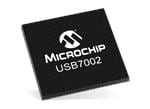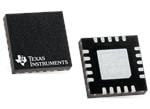So... What's new in USB?

Image Source: Ruslan Khismatov/shutterstock.com
In the 24 years since it was first introduced, Universal Serial Bus (USB) connectivity's proliferation throughout the global electronics industry has been unprecedented. Now boasting annual shipments of over 3 billion ports, USB is by far the most commonly utilized interface technology—with laptops, tablets, smartphones, and various other items of equipment all relying on it for the movement of power and data. The functional capabilities of USB today go way beyond what it originally offered. Both the data rates and power levels supported have risen by several orders of magnitude— and, because of this unrelenting evolution, it is closer than any other connectivity solution has ever been to becoming ubiquitous.
USB Interface
Through the Type-C connector, a more compact form factor for USB interfacing has now been realized. This has been highly beneficial for original equipment manufacturers (OEMs), enabling them to develop sleeker and more aesthetically pleasing designs for their products. It also means that (finally!) the orientation of the connector in relation to the port is not important when it comes to mating—something that was a major frustration for users in the past. Then, there are the elevated data rates that can now be implemented via USB technology. The USB 3.1 standard can cope with up to 10Gbps—which gives the standard comparable bandwidth to Ethernet, DisplayPort, HDMI, and suchlike, with a strong case for it supplanting these other connectivity options in many application scenarios.
USB Products
A multitude of cutting-edge semiconductor products help engineers with deploying USB technology in their design projects. Microchip's USB7002 is a quad-port USB 3.1-compliant controller IC that can handle two USB 3.1 Gen 1 downstream ports with USB Type-C connectors, plus two USB 2.0 SuperSpeed ports with conventional Type-A connectors. It is supplied in a 12mm x 12mm x 0.9mm VQFN-100 package to keep board real-estate utilization to a minimum, with target applications for it, including home media hubs and vehicle infotainment systems. Encompassing seven downstream ports, the HX3PD USB 3.1 Gen 2 Type-C hub controller from Cypress® is intended for use in notebook and tablet docking stations, monitor docks, etc. Its high degree of integration makes docking system designs more streamlined and keeps the overall component count low. Each IC has dual Arm® Cortex®-MO cores, along with 256kB of Flash memory resource. Support for older USB standards (High-Speed, Full-Speed, etc.) enables back compatibility. I2C, SPI, UART, and GPIO interfaces are also incorporated for greater versatility. Its programmability means that this IC is futureproofed against possible changes to USB specifications in years to come.

Figure 1: Microchip USB7002 (Source: Mouser Electronics)
USB Communications
The heightened data rates that USB technology can now accommodate raise signal integrity issues. This will be imperative when HD video content is being transported, especially over long distances. Jitter, crosstalk and channel loss all need to be mitigated. The pinouts of NXP's CBTU02043 are optimized to eliminate crosstalk. This 3.1 USB multiplexer switch IC possesses low insertion loss (-1.4dB at 5GHz and -0.5dB at 100MHz), as well as a low return loss (approximately -16dB at 2.5GHz). 2kV HBM ESD protection is another key feature. The Texas Instruments HD3SS3212x dual-channel, bi-directional differential multiplexer/demultiplexer switch is aimed at USB Type-C system designs, and supports both USB 3.1 Gen 1 and Gen 2 data rates. It has a crosstalk figure of -32dB (typical) and a -12dB return loss. Strong dynamic characteristics mean that this IC can undertake high-speed switching without heavy jitter.

Figure 2: Texas Instruments HD#SS3212x (Source: Mouser Electronics)
It is not all about the data rates and signal-to-noise ratios though. The ability to transfer power and data through the same interface has always been what gave USB its charm, and has been pivotal to the continued longevity of the standard. In recent years, the power delivery aspect of USB has beefed up considerably. The advent of Revision 3.0 of the USB Power Delivery Specification pushes power levels up to a staggering 100W (in stark contrast to the 2.5W that the initial USB specification could carry). Also, as part of this standard, the direction of charging is no longer fixed—with the powered device (PD) able to serve as a power source under the right circumstances. STMicroelectronics' STUSB47 autonomous Type-C USB power delivery controller IC has the built-in intelligence needed to detect a connected PD then gauge the amount of power to be given to it, all without the need for involvement from the system microcontroller unit (MCU)—making the whole process considerably more efficient. It supports all current USB PD profiles and is fully compliant with USB Power Delivery Specification Revision 2.0.
Recently introduced are the AP22815 and AP22615 from Diodes Inc. These 3A single-channel high-side USB power switch ICs will protect portable electronics equipment and computer peripherals from the potential threats now posed by hot-swapping, as voltage levels rise. Like the FTDI IC, they are fully compliant with the latest USB power delivery standards. Over-voltage, over-current, short-circuit and over-temperature mechanisms are all included, as well as under-voltage lock-out and controlled rise-time, plus a discharge function for external storage capacitors. Supplied in a TSOT25 package, the AP22815 has fixed current limit functionality, while the AP22615 comes in a TSOT26 package and has an adjustable current limit. Thanks to incorporation of the company's proprietary copper-pillar packaging technology, these ICs exhibit ultra-low on-resistance values (typically 40mω). They are able to detect and react to the presence (or absence) of a power rail in just 150μs.

Figure 3: Diodes Inc. AP22815 / AP22615 TSOT26 package (Source: Mouser Electronics)
USB Outlooks
Welcomed by both consumers and OEMs, the latest USB incarnation is able to deliver elevated performance benchmarks and greater convenience, too. Substantial obstacles are ahead, though—in relation to data security and to ensuring safety in high-power charging modes. There are also OEM compatibility issues to overcome, with different consumer electronics manufacturers not allowing fast charging through their adapters when connected to equipment from their competitors, for example. This goes against the whole ethos that USB is trying to instill within the industry, and hopes are that the problem will be resolved in the near future. Looking ahead, USB 3.2 will open up additional lanes to further expand the available bandwidth, so that data rates of 20Gbps can be supported. There will, however, be technical challenges to tackle—relating to upholding signal integrity, as well as the effects of voltage surges, and ESD strikes and electromagnetic interference (EMI).